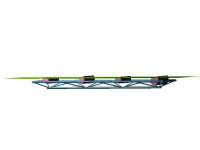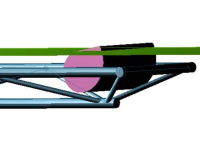Salter’s Duck is a wave energy conversion device invented by Dr. Stephen Salter in 1974 at the University of Edinburgh. The device is unique among wave energy conversion systems in that it uses both the vertical and horizontal motion of the wave. It has a pear shaped cross section that “nods,” rotates around its center, in response to wave forces. The nodding motion can then be transformed into power via hydraulics, air pressure or direct electrical generation for electrical utilities or various other uses such as desalination, oxygen injection into “dead” zones in littoral water or for fluid reinjection into offshore oil formations.
Like most wave energy collection devices, the Duck needs a fixed point that doesn't follow the waves to exert force and motion on. There have been a number of schemes to provide either a rigid mooring to the bottom or a large mass, well submerged so that it doesn't move, to provide this “reference,” but this increases the cost of the device. One scheme also used an array of Ducks, side by side parallel to the wave crest , but in some cases the Ducks are in phase, so ther is no relative movement between them to derive energy, and the spine connecting them side by side is a structural challenge.
All wave energy devices also have a frequency response to wave energy, absorbing the maximum energy in waves at their natural frequency. In the case of the Duck, the natural frequency is dependent on the size, the spring rate of the energy transfer mechanism, and the location of the center of gravity of the Duck.
None of these parameters are easily adjusted enough to make a substantial change in natural frequency.
The Salter-McCloskey device attacks these issues by arraying the Ducks perpendicular to the wave crest, in an array inspired by Robert McCloskey’s famous children’s book “Make Way for Ducklings.” Several Ducks are attached to a truss-like frame long enough to span the design wave. The frame itself is relatively light and simple and the Ducks together thereby provide the reference themselves, and move relative to the frame. In waves longer than the design wave, the whole frame and Duck system is in resonance and moves opposite the wave, providing substantial energy of motion for the Ducks to absorb. In the design wave or less, the frame is relatively motionless, and the individual Ducks absorb energy from the shorter, higher frequency waves as they pass through the system. Each Duck is tuned to a differ frequency wave so it absorbs the maximum energy from the wave spectrum. The difference in resonance also reduces the tendency of the Ducks to shadow one another, even though most real seas are somewhat multidirectional in any case. The device would have a single point moor to allow it to keep station (and export power) but the mooring would be relatively simple.
This is a low cost approach to wave energy collection and may allow practical alternative energy from the waves.
Like this entry?
-
About the Entrant
- Name:Christopher Barry
- Type of entry:individual
- Software used for this entry:Excel, TurboCAD
- Patent status:none





